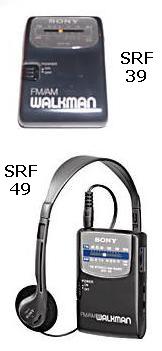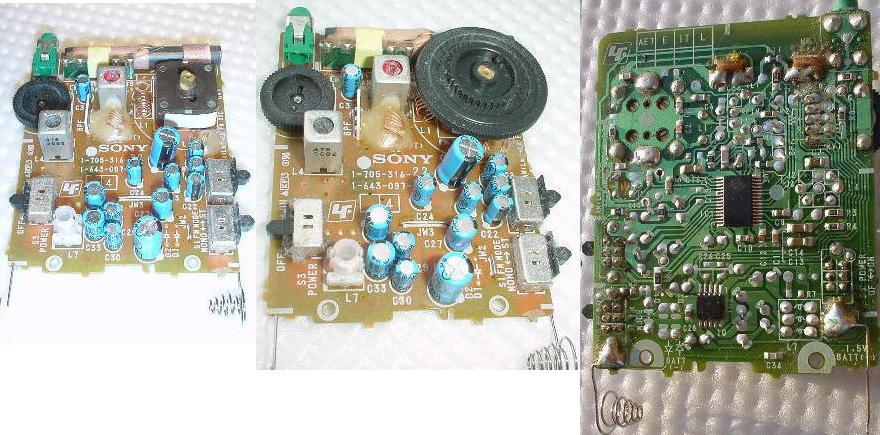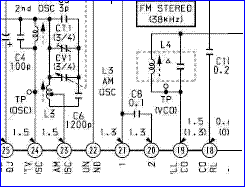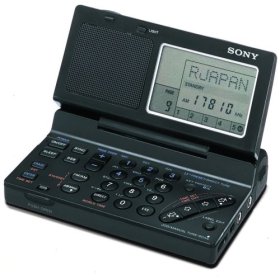Models I know of are the SRF-39, SRF-49, SRF-59, SRF-S83, SRF-S84 & SRF-PSY03


The Walkman series of radios from Sony have seen changes over the last few years, to make them smaller and cheaper to produce. Surprisingly, the reception performance has improved significantly, thanks to a new approach to circuit topology. They now run on a single AA cell of 1½V with an exceptionally long operating time, the supply current being 20mA quiescent, 25mA maximum.

2 ICs are used: CXA1129N for the receiver + stereo decoder, LA4537M for the stereo headphone amplifier.
The single-IC receiver is completely unconventional in terms of consumer electronics, using techniques previously only found in professional equipment, usually for microwaves. Low intermediate frequencies are used, with the bandpass filtering defined as 'lowpass' and seemingly involving no external filter components. To avoid problems of mixing image frequencies, the 'image reject mixer' technique is used, with two mixers fed with quadrature LO signals, and the outputs shifted in phase before being combined. The quadrature LO signals are derived by binary division of a twice-frequency oscillator. See the block diagram.

I cannot explain the IF filtering, but there is no suggestion that it is accomplished in the digital domain. The schematic shows the filtering either as BPF or LPF. Maybe commutating capacitor filtering is used. If anyone has the answer, please let me know. Whatever the technique, it is remarkably effective, giving performance equivalent to several high quality conventional filters.
For AM, the IF is nominally 55kHz. The tuned ferrite rod antenna is conventional, but the mixer is image-rejecting, the oscillator running at twice the conversion frequency.
For FM, dual conversion is used. The 1st IF has no bandpass filtering, and the 1st mixer is conventional. Image responses are controlled by the use of a bandpass filter of hybrid structure at the antenna input, plus a conventional tracking tuned circuit. The 1st IF frequency is nominally about 28.4MHz and the 1st LO frequency is high-side. The 2nd mixer is image rejecting, the oscillator running at nominally 57.1MHz, being twice the injection frequency of 28.55MHz. The 2nd IF seems to be nominally 120kHz.
This approach results in a very low component count, and requires very few alignment adjustments. The previous generation of small Sony portables also used a single IC (CXA1019) which drives a (mono) speaker and runs from a 3V supply at a much lower quiescent current. However, the RF performance of these sets is compromised in the interests of reducing component count. One IF coil & a ceramic filter are typically used on AM, no IF coils are used for FM, just a single cerafil plus a ceramic resonator for the discriminator. Both the near-channel and far-out rejection are noticeably feeble, but it hardly matters for a 'pocket portable' radio.
The selectivity of the CXA1129N radios, and freedom from spurious responses, are impressive, and have brought them to the attention of several medium-wave dx-ers, despite the very low sensitivity resulting from the use of a ferrite rod antenna only 45mm long. Adjacent-channel rejection approaches the ideal 'brick wall' response, while the passband is wide enough for unusually good audio quality. Quick measurements show a bandwidth of 16kHz (±8kHz) with steep sides, opening out below about -20dB. If the tuning is not centred in the passband, audio response in excess of 12kHz is demonstrated, but with a sharp notch at 9.0kHz. Maybe the US versions feature a 10kHz notch..?
For FM, AFC is applied to the 1st LO (not shown on the diagrams) and results in pull-in greater than 100kHz even with the weakest signals. In the absence of a signal, the AFC sweeps the tuning randomly under the influence of noise, and will quickly re-capture if the signal level drops out, as it often does when on the move.
I would love to know of any larger or higher-specification receivers from Sony to use the CXA1129N. Maybe they will feature in car radios, or all-band short-wave receivers. There's no reason why they should not be used with PLL tuning and multiple bands, and may yet appear in high-end all-band radios. I wonder if it is used in the Sony ICF-SW100E 'Super Compact World Band Receiver'? They may also have been used for TV receiver applications.

Schematic diagram - 82KB
Zipped files of other service information are available here - 470KB
LINKS
DXer.CA has several enthusiastic articles, including this review
and be sure to navigate through the Downloads pages to a major review & history by 'Kevin S' (PDF)
I had a fault on mine - the audio quality gradually grew thinner and the bass response dropped off progressively. I examined the shematic for a clue. Both channels were affected equally, both on FM & AM. The only likely culprit seemed to be C23. I opened up the receiver and took some measurements. The eventual finding was... the earphones were dying, slowly and simultaneously. I can't explain!
There has been no change since I replaced the earphones with a pair of the same model, 4 years ago
UPDATE
Recent production models since about 2012 have replaced the Stereo/Mono switch with a switch marked FM SENS DX / LOCAL and rely on the auto switching of the stereo decoder. This is unhelpful, as in most circumstances it acts as a NOISY / CLEAR switch. Manual selection of mono is helpful when travelling as it prevents the irritation of constant switching between mono and stereo. There must have been problems when you are very close to a transmitter
JH - Apr.08, revised Aug.13